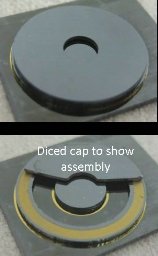May 15 2010
If you've ever used an iPhone, a Wii video game or an automobile airbag, you've benefited from micro-electro-mechanical systems (MEMS) technology, in which arrays of tiny devices mounted on computer chips - many no larger than the width of a human hair - are able to sense and respond to changes in heat, light, motion, sound or other external stimuli.
 5-millimeter silicon rotary stage fabricated by UCLA engineers
5-millimeter silicon rotary stage fabricated by UCLA engineers
Now, the UCLA Henry Samueli School of Engineering and Applied Science has been awarded $5.5 million from the U.S. Defense Department's central research and development agency to advance MEMS technology for use in defense systems.
The four-and-a-half-year grant from the Defense Advanced Research Project Agency (DARPA) will fund research by UCLA engineers to create electrically connected, rotating microscale motors for sensing and communications as part of the agency's Information Tethered Micro Automated Rotary Stages program.
The micromachining techniques used to fabricate microdevices have been highly successful in producing miniature systems and components - including sensors, actuators and electronics - that combine high performance with low weight and power consumption. And early MEMS work demonstrated multiple avenues for realizing micromotors that are able to rotate 360 degrees.
But even with the progress of MEMS technology, the use of rotating microdevices has not been as widespread as might be expected, according to DARPA, primarily because most applications have used structures fabricated into rotary stages without the availability of active electrical power, limiting the utility of the stages.
"Providing electric connections can be a little tricky, especially on continuous rotating platforms," said Chang-Jin "CJ" Kim, a professor of mechanical and aerospace engineering at UCLA Engineering and principal investigator on the DARPA project. "You rarely see physically free objects electrically connected. You can't have electrical wires protruding from an object that rotates endlessly. So that's one of the challenges we are facing."
Providing electrical power on a stage while allowing full rotation and precise position control of these components would lead to microsystems with much higher performance and functionality.
The goal of the UCLA Engineering team is to demonstrate a MEMS-fabricated rotary stage that would enable free rotation coupled with electrical power and signal transfer. This would launch the implementation of sensing and device operations on a microstage with position-measuring accuracies that would most likely be better than those obtained by large, instrumented optical rotary stages.
Thus far, Kim's group has successfully created a rotary stage using liquid droplets as the mechanical element that serves as a bridge between two moving objects. The liquid droplets, formed into a series of rings, provide physical support as well as rotational lubrication to the stage and allow for multiple stable electrical connections.
"On the microscale, smaller than a millimeter, the surface tension of liquid droplets, in terms of strength, is stronger than the weight of the droplet," said Kim, who specializes in MEMS. "That's why a smaller water droplet beads more and spreads less than a larger droplet. It stays in the form of a sphere. The smaller it gets, the greater the effect of surface tension gets. With liquid bearings formed by free droplets, only because they are very small, there is no solid-to-solid contact and there is no wear."
Kim's rings are made of liquid metals or ionic liquid, which not only allows for higher power but also leads to more stable electrical contact.
The team's next step will be to use electric signals to rotate the stage. Thus far, the capability to precisely rotate micromachined structures in a controllable manner has not been achieved.
"The rotary stage will be electro-statically activated by high-voltages applied across electrodes placed beneath the stage, and the high voltages will be applied by a high-voltage driver circuit," said Ken Yang, a professor of electrical engineering at UCLA Engineering and a co-principal investigator responsible for the development of the electronic interface that controls the rotary stage.
"The position of the stage will roughly be determined by activating a proper set of electrodes," Yang said. "The capacitance between electrodes will be a measure of the precise position. The control electronics will determine the appropriate sequence of binary voltages driven to each electrode. This will determine how the stage moves, in what direction, and how fast. We intend for the controller to be fully incorporated on an integrated circuit, also located beneath the rotor."
Once the team shows proof of concept, they will concentrate on making the motorized rotary stage smaller, more accurate and more efficient.
Source: http://www.ucla.edu/